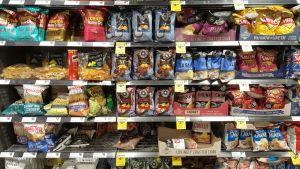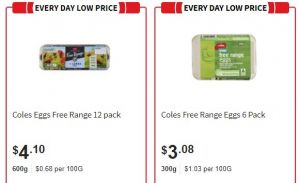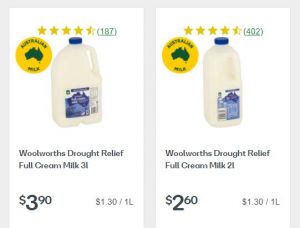If you’re feeling the pinch of rising prices, especially at the supermarket, you’re not alone. A recent Canstar Blue survey revealed a whopping 71% of Australian shoppers have noticed the price of usual grocery items has increased. One way to stretch your budget further and cut down your grocery bill is to look at unit pricing – which tells you the REAL cost or value of a product. We cover everything you need to know about unit pricing below.
What is unit pricing?
Unit pricing is a mandatory labelling system (under the Competition and Consumer Act 2010) that basically tells you the price per unit of a product, or in other words, the cost per litre, per gram, or kilogram (or whatever unit of measurement) of what you want to buy. It basically works as a standard unit of measurement that allows shoppers to easily compare the prices of products, regardless of size, brand, or packaging. Grocery unit prices are calculated to the nearest dollar and cent. You should be able to spot a product’s unit price on the shelf label if you’re shopping in a store or below a product image if you’re shopping online. Specials catalogues will also display unit pricing. This helps compare prices of products on special with full-priced items to determine whether you’re actually getting good value or not.

How is unit pricing displayed?
Here are the standard unit price measurements for various types of grocery items.
| Items sold by | Unit pricing measurement | Product examples |
| Weight | Per 100 grams | Rice, pasta, soups & spreads |
| Capacity/volume | Per 100 millilitres | Salad dressing, sauces & cooking creams |
| Length | Per metre | Tape measure, wrapping paper |
| By number | Per item included (each) | Cleaning cloths, sponges & pegs |
Certain grocery products aren’t subject to the same units of measurement − fruits, vegetables, meats, and seafood which are typically sold by weight, are generally displayed with a unit price per kilogram or per item. Milk and other beverages like cordial and soft drinks are measured per litre.
How to compare grocery prices with unit pricing
As mentioned, unit pricing offers a true comparison of grocery products regardless of their size, brand, or packaging. It’s also a great idea to check the unit price on sale products to determine whether you’re really getting a good deal or just clever marketing from supermarkets. Use unit pricing to also compare pack sizes to see which represents better value for money.
Here’s how to use unit pricing to compare a product, in this instance, eggs.

- In this case, Coles’ bigger carton with a dozen eggs may cost a dollar more to buy but offers better value for money with a unit price of $0.68 per 100g, compared to the smaller carton with six eggs which has a unit price of $1.03 per 100g.
Here’s how to use unit pricing to compare a product, in this instance, milk.

- In this case, Woolworths Drought Relief 2L and 3L full cream milk are on par in terms of value with an equal unit pricing of $1.30 per litre.
Hot tip: Keep in mind that everything you buy in bulk or on sale isn’t always a good deal. The same goes for homebrand products. Sometimes fresh produce can be of better value, while other times canned or frozen foods may be cheaper. That’s where unit pricing is handy because it offers a true ‘apples with apples’ comparison of all products.
How to calculate unit pricing yourself
If you can’t find the unit price on a particular product, you can easily calculate it yourself with this formula:
- Laundry detergent A costs $7.50 for a 2.5 litre bottle − $7.50 ÷5 = unit price is $3 per litre
- Laundry detergent B costs $6.20 for a 1.5 litre bottle − $6.20 ÷5 = unit price is $4.13 per litre.
The best value product is therefore laundry detergent A.
Do all supermarkets display unit pricing?
Under Australian consumer law, supermarkets and large grocery stores are required to display unit pricing on all food products and grocery items. This applies to both physical stores and to online shopping as well. All rules have exceptions though, and there are products exempt from the Unit Pricing Code including magazines and stationery, flowers, toys, appliances, electronic gadgets, and alcohol and cigarettes.

Is unit pricing displayed on sale items?
Yes, unit pricing must also be displayed on sale items and promotional offers, including on 2 for 1 deals, and where two or more of the same grocery items are offered for a single price; like two bottles of soft drinks for $5 or four cans of tuna sold for $3.
However, a retailer is not required have to display unit prices when:
- different grocery items are sold together in a bundle (i.e. meal kits with different ingredients)
- similar items of different sizes or weights are sold at a single price (i.e. chocolates of different sizes sold for $2)
- the item has been marked down because the packaging is damaged, or if the product is nearing its expiry date or discontinued.
How to get a better deal with unit pricing
You can use unit pricing to get better value for money by comparing:
- products of different brands
- different package sizes and package types from the same brand and across brands
- packaged and loose items (i.e. oranges, potatoes)
- fresh, frozen, or canned foods (i.e. beans, corn)
- similar or substitute products (i.e. rice, pasta, cheese)
- items on sale and full price
- different grocery retailers, including online stores.



Share this article